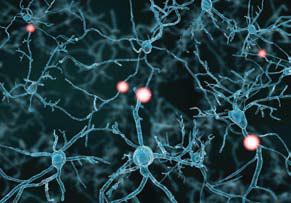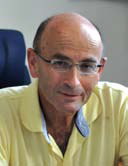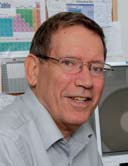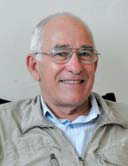Prostate Cancer and Alzheimer’s Disease
According to the World Health Organization (WHO), in 1900, the global average life span was 31 years of age. By 2030, in highly developed places such as the U.S., average life expectancy at birth is expected to be around 85. And while wisdom may come with age, so do many unwanted issues, such as poor physical and mental health. In addition, an aging population takes a toll on society: older people are often harder to treat medically; it can be more challenging to get around, either on foot or by driving; and general quality of life may be reduced.
As the population in many countries trends towards maturity, keeping people healthy as they age is a priority. At the Weizmann Institute of Science in Israel, research is taking place on a number of conditions that are more likely to arise later in life, such as prostate cancer and Alzheimer’s disease. Following are some examples of how the Weizmann Institute is working to help humanity live longer—and healthier—lives.
A Toxic Combination:
VTP Destroys Prostate Cancer

As men age, their risk of developing prostate cancer increases exponentially, says the Prostate Cancer Foundation, with more than 65% of all prostate cancers diagnosed in men over 65. And in the U.S., one in six men are affected, making it the most common cancer (other than skin cancers). Fortunately, by combining individually benign components, Prof. Yoram Salomon of the Weizmann Institute’s Department of Biological Regulation and Prof. Avigdor Scherz of the Department of Plant Sciences have created a toxic combination that destroys prostate tumors. This cancer therapy—the result of nearly 20 years of collaboration between the two scientists—is being studied as a frontline treatment for prostate cancer, although the strategy may work for other types of cancer as well. “In principle, right now, every solid tumor is potentially a target for this treatment,” says Prof. Salomon.
The scientists developed a photosensitized drug, made from chlorophyll, that is injected into the patient. Light is then applied via highly focused fiber-optic lasers inserted near the tumor. As the chlorophyll absorbs the light, it interacts with oxygen to produce oxygen radicals. This interaction initiates a cascade of events that cause instantaneous closing of the blood vessels leading to the tumor, followed by oxygen and nutrient deprivation at the tumor site, as well as other active processes that kill tumor cells. In 24 to 48 hours, the tumor undergoes complete necrosis.
This treatment, called vascular-targeted photodynamic therapy, or VTP, offers numerous advantages over general photodynamic therapy and other existing cancer treatments. For example, VTP is a 20-to-30-minute one-time treatment; is minimally invasive and minimally immobilizing; and no side effects in urination or sexual function have been observed. Clinical trials on the use of VTP for prostate cancer are ongoing in several locations worldwide, and more are anticipated. Other possible future targets of the treatment include breast, ovary, lung, and pancreatic tumors. Thanks to this unique collaboration between two scientists who combine biology, chemistry, and the plant sciences, safer, innovative treatments are becoming a reality for prostate cancer patients.
Analyzing Alzheimer’s:
Better Understanding for Better Treatment

One in 10 Americans over the age of 65 has Alzheimer’s disease, a debilitating neurological disorder that slowly destroys memory and cognitive function and for which there is no cure. According to the National Institutes of Health (NIH), because the risk of developing the disease increases with age and more people are living longer, the number of people suffering from Alzheimer’s is likely to grow dramatically.
Despite decades of research by scientists, Alzheimer’s is still poorly understood. Prof. Joel Sussman of the Weizmann Institute’s Department of Structural Biology Department of Structural Biology, who studies nervous system proteins involved in Alzheimer’s disease and other neurological disorders, is working to change that. For more than 20 years, he and Prof. Israel Silman of the Department of Neurobiology have been studying the three-dimensional (3D) structures of such proteins in order to better understand how they function. This research also helps them develop ideas for improving existing Alzheimer’s drugs and design new ones that are more effective and have fewer side effects.
Many of their studies focus on a brain enzyme called acetylcholinesterase (AChE) that is thought to play a crucial role in Alzheimer’s disease. Memory loss and other cognitive deficits in Alzheimer’s patients result from the deterioration of brain cells that release a substance called acetylcholine—a message-carrying neurotransmitter. The acetylcholine shortage is compounded by the action of AChE, which breaks down acetylcholine in the body. “One of the ways of treating Alzheimer’s is to slow down the activity of this enzyme [AChE] and, thus, artificially raise the levels of acetylcholine,” says Prof. Sussman.

He and his colleagues were the first to determine the 3D structure of AChE. Since then, they’ve revealed the 3D structure of several major FDA-approved drugs used to treat Alzheimer’s and discovered that the drugs all work by inhibiting AChE activity in order to restore acetylcholine levels. While these medicines don’t cure Alzheimer’s, they can help counteract memory loss and prevent symptoms from becoming worse for a period of time. Prof. Sussman also unraveled the 3D structure of huperzine A, an extract from a Chinese herb used for centuries to treat memory disorders. The team found that although huperzine A differed in chemical structure from the Food and Drug Administration- (FDA-) approved medicines, it worked in the same way—by blocking AChE activity. Prof. Sussman hopes that this research will give hope to Alzheimer’s sufferers and lead to new, or better, treatments for this increasingly common disease.

Prof. Avigdor Scherz is the incumbent of the Yadelle and Robert N. Sklare Professorial Chair in Biochemistry.

Prof. Joel Sussman is the incumbent of the Morton and Gladys Pickman Professorial Chair in Structural Biology.

Prof. Yoram Salomon is the incumbent of the Charles W. and Tillie K. Lubin Professorial Chair of Hormone Research.
